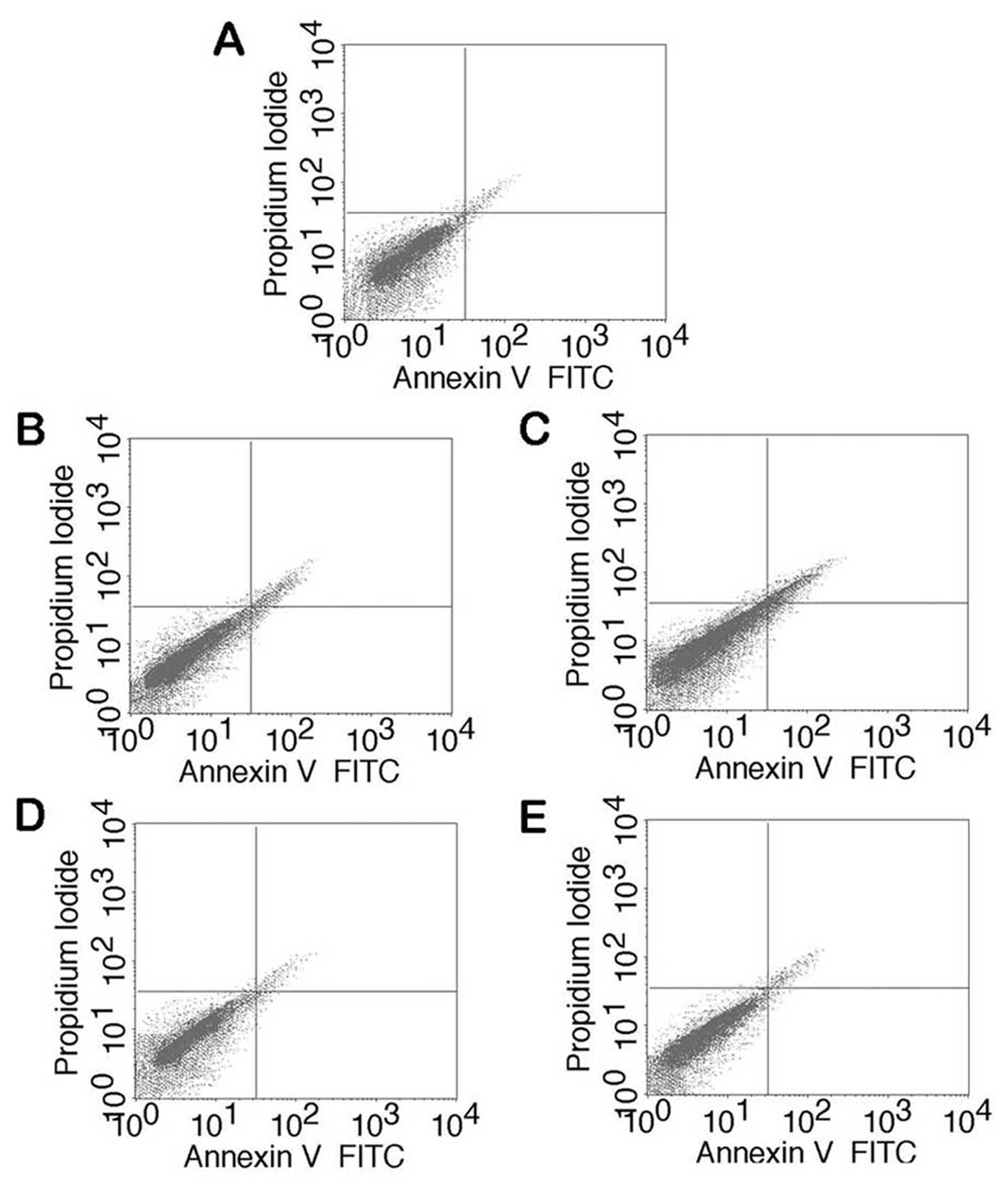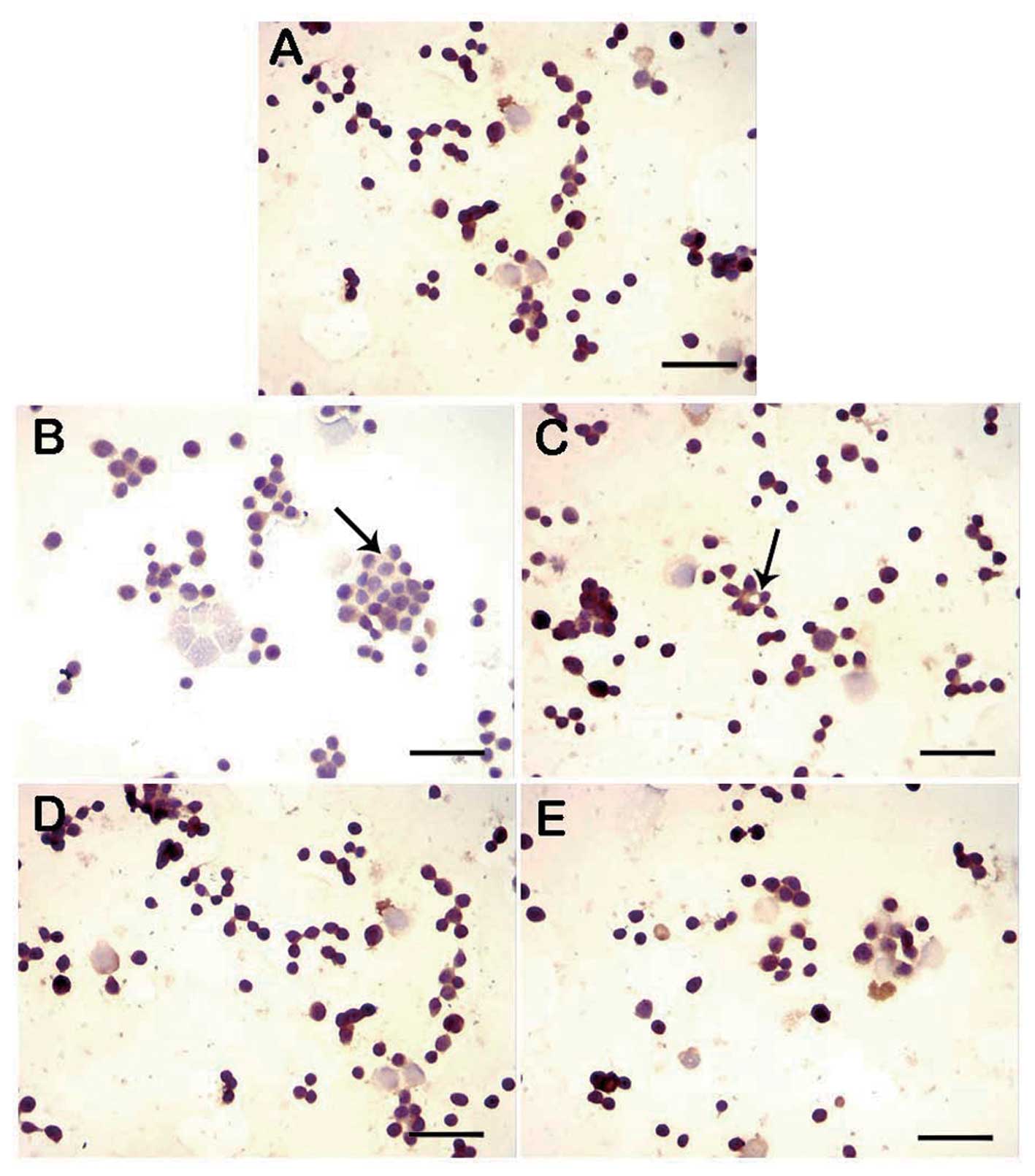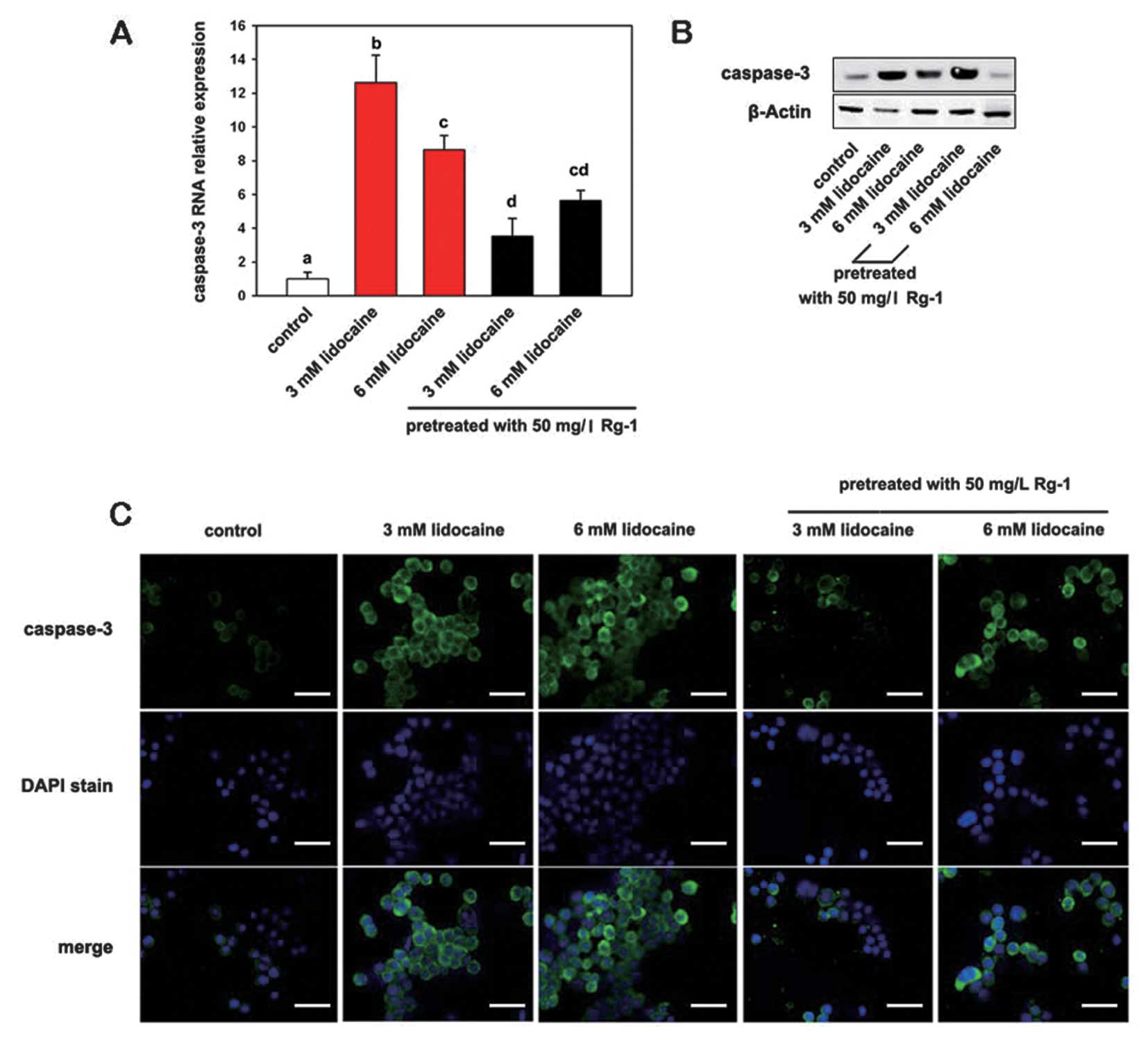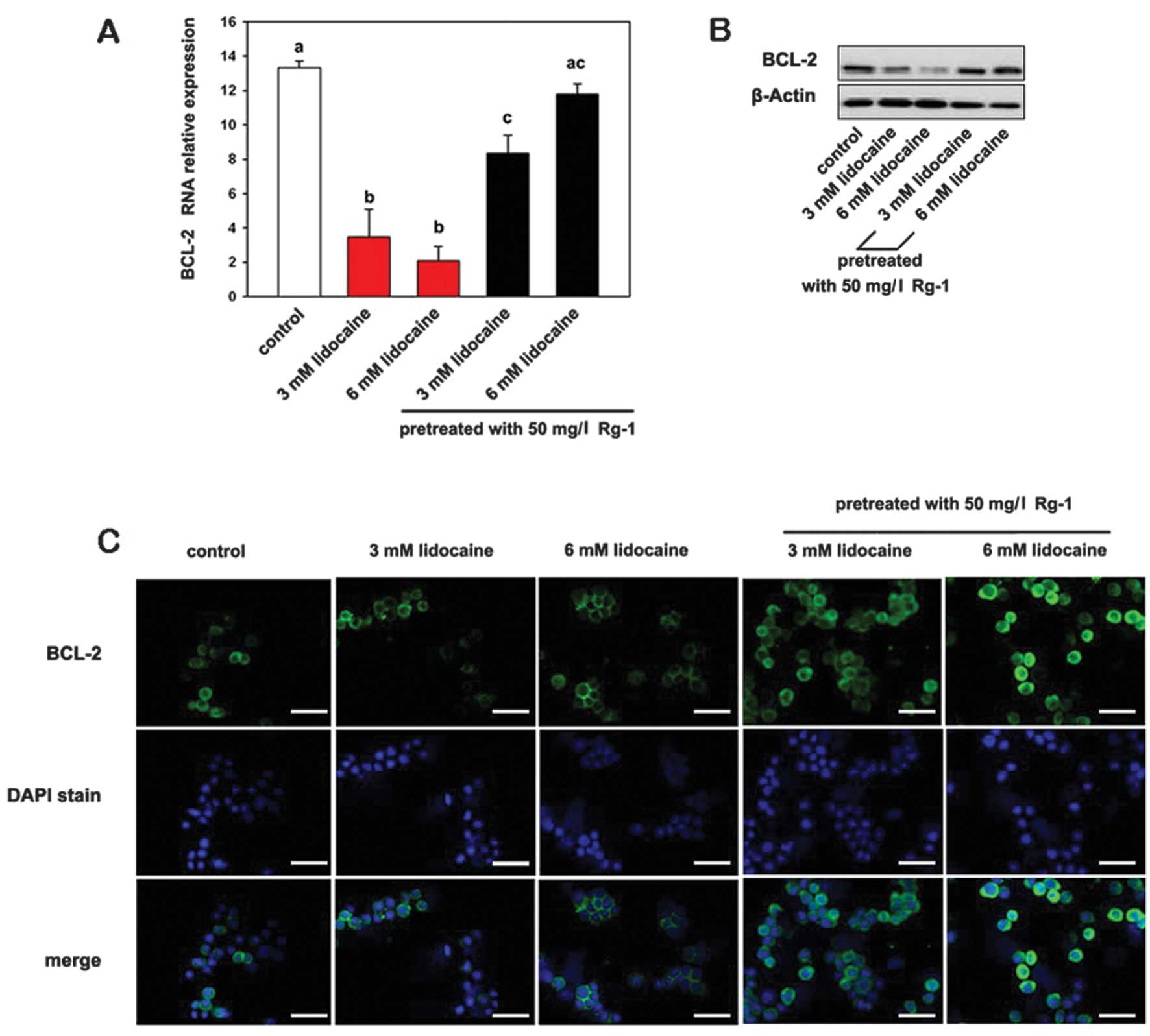|
1
|
Mazoit JX and Cao LS: Local anaesthetic
toxicity. Curr Opin Anaesthesiol. 8:409–413. 1995. View Article : Google Scholar
|
|
2
|
Del Valle LJ and Orihuela PA: Cleavage and
development in cultured preimplantation mouse embryos exposed to
lidocaine. Reprod Toxicol. 10:491–496. 1996.PubMed/NCBI
|
|
3
|
Saadé NE, Al Amin HA, Barchini J,
Tchachaghian S, et al: Brainstem injection of lidocaine releases
the descending pain-inhibitory mechanisms in a rat model of
mononeuropathy. Exp Neurol. 237:180–190. 2012.PubMed/NCBI
|
|
4
|
Friederich P and Schmitz T:
Lidocaine-induced cell death in a human model of neuronal
apoptosis. Eur J Anaesthesiol. 19:564–570. 2002. View Article : Google Scholar : PubMed/NCBI
|
|
5
|
Johnson ME, Uhl CB, Spittler KH, Wang H
and Gores GJ: Mitochondrial injury and caspase activation by the
local anesthetic lidocaine. Anesthesiology. 101:1184–1194. 2004.
View Article : Google Scholar : PubMed/NCBI
|
|
6
|
Werdehausen R, Braun S, Essmann F,
Schulze-Osthoff K, et al: Lidocaine induces apoptosis via the
mitochondrial pathway independently of death receptor signaling.
Anesthesiology. 107:136–143. 2007. View Article : Google Scholar : PubMed/NCBI
|
|
7
|
Hon CC, Chow YC, Zeng FY and Leung FC:
Genetic authentication of ginseng and other traditional Chinese
medicine. Acta Pharmacol Sin. 24:841–846. 2003.PubMed/NCBI
|
|
8
|
Qi LW, Wang CZ and Yuan CS: Ginsenosides
from American ginseng: chemical and pharmacological diversity.
Phytochemistry. 72:689–699. 2011. View Article : Google Scholar : PubMed/NCBI
|
|
9
|
Attele AS, Wu JA and Yuan CS: Ginseng
pharmacology: multiple constituents and multiple actions. Biochem
Pharmacol. 58:1685–1693. 1999. View Article : Google Scholar : PubMed/NCBI
|
|
10
|
Tawab MA, Bahr U, Karas M, Wurglics M and
Schubert-Zsilavecz M: Degradation of ginsenosides in humans after
oral administration. Drug Metab Dispos. 31:1065–1071. 2003.
View Article : Google Scholar : PubMed/NCBI
|
|
11
|
Yi LN, Yin XY, Jiang YF and Liu QS:
Preparation and properties of ginsenoside Rg1 molecularly imprinted
polymers. Adv Mat Res. 550–553:1715–1718. 2012.PubMed/NCBI
|
|
12
|
Wu J, Pan Z, Wang Z, Zhu W, et al:
Ginsenoside Rg1 protection against β-amyloid peptide-induced
neuronal apoptosis via estrogen receptor α and glucocorticoid
receptor-dependent anti-protein nitration pathway.
Neuropharmacology. 63:349–361. 2012.
|
|
13
|
Zhang DF, Xu H, Sun BB, Li JQ, et al:
Adjuvant effect of ginsenoside-based nanoparticles (ginsomes) on
the recombinant vaccine against Eimeria tenella in chickens.
Parasitol Res. 110:2445–2453. 2012. View Article : Google Scholar : PubMed/NCBI
|
|
14
|
Drasner K: Local Anesthetic neurotoxicity
and cauda equina syndrome. Complications in regional anesthesia and
pain medicine. Neal and Rathmell JP: Lippincott, Williams and
Wilkins; Philadelphia, PA, USA: pp. 1252012
|
|
15
|
Vaghadia H, Neilson G and Lennox PH:
Selective spinal anesthesia for outpatient transurethral
prostatectomy (TURP): randomized controlled comparison of
chloroprocaine with lidocaine. Acta Anaesthesiol Scand. 56:217–223.
2012. View Article : Google Scholar
|
|
16
|
Hahnenkamp K, Herroeder S and Hollmann MW:
Regional anaesthesia, local anaesthetics and the surgical stress
response. Best Pract Res Clin Anaesthesiol. 18:509–527. 2004.
View Article : Google Scholar : PubMed/NCBI
|
|
17
|
Hampl KF, Schneider MC, Pargger H, Gut J,
et al: A similar incidence of transient neurologic symptoms after
spinal anesthesia with 2% and 5% lidocaine. Anesth Analg.
83:1051–1054. 1996.
|
|
18
|
Gerancher JC: Cauda equina syndrome
following a single spinal administration of 5% hyperbaric lidocaine
through a 25-gauge Whitacre needle. Anesthesiology. 87:687–689.
1997.
|
|
19
|
Zaric D, Christiansen C, Pace NL and
Punjasawadwong Y: Transient neurologic symptoms after spinal
anesthesia with lidocaine versus other local anesthetics: a
systematic review of randomized, controlled trials. Anesth Analg.
100:1811–1816. 2005. View Article : Google Scholar
|
|
20
|
Chan RY, Chen WF, Dong A, Guo D and Wong
MS: Estrogen-like activity of ginsenoside Rg1 derived from Panax
notoginseng. J Clin Endocrinol Metab. 87:3691–3695. 2002.
View Article : Google Scholar : PubMed/NCBI
|
|
21
|
Leung KW, Yung KK, Mak NK, Yue PY, et al:
Angiomodulatory and neurological effects of ginsenosides. Curr Med
Chem. 14:1371–1380. 2007. View Article : Google Scholar : PubMed/NCBI
|
|
22
|
Saraste A and Pulkki K: Morphologic and
biochemical hallmarks of apoptosis. Cardiovasc Res. 45:528–537.
2000. View Article : Google Scholar
|
|
23
|
Slee EA, Adrain C and Martin SJ:
Executioner caspase-3, -6 and -7 perform distinct, non-redundant
roles during the demolition phase of apoptosis. J Biol Chem.
276:7320–7326. 2001. View Article : Google Scholar : PubMed/NCBI
|
|
24
|
Fan TJ, Han LH, Cong RS and Liang J:
Caspase family proteases and apoptosis. Acta Biochim Biophys Sin
(Shanghai). 37:719–727. 2005. View Article : Google Scholar : PubMed/NCBI
|
|
25
|
Jänicke RU, Sprengart ML, Wati MR and
Porter AG: Caspase-3 is required for DNA fragmentation and
morphological changes associated with apoptosis. J Biol Chem.
273:9357–9360. 1998.
|
|
26
|
Porter AG and Jänicke RU: Emerging roles
of caspase-3 in apoptosis. Cell Death Differ. 6:99–104. 1999.
View Article : Google Scholar : PubMed/NCBI
|
|
27
|
Dai ZJ, Gao J, Ji ZZ, Wang XJ, et al:
Matrine induces apoptosis in gastric carcinoma cells via alteration
of Fas/FasL and activation of caspase-3. J Ethnopharmacol.
123:91–96. 2009. View Article : Google Scholar : PubMed/NCBI
|
|
28
|
Chipuk JE and Green DR: How do BCL-2
proteins induce mitochondrial outer membrane permeabilization?
Trends Cell Biol. 18:157–164. 2008. View Article : Google Scholar : PubMed/NCBI
|
|
29
|
Hengartner MO: The biochemistry of
apoptosis. Nature. 407:770–776. 2000. View
Article : Google Scholar : PubMed/NCBI
|
|
30
|
Danial NN and Korsmeyer SJ: Cell death:
critical control points. Cell. 116:205–219. 2004. View Article : Google Scholar : PubMed/NCBI
|
|
31
|
Cheng EH, Wei MC, Weiler S, Flavell RA, et
al: BCL-2, BCL-X(L) sequester BH3 domain-only molecules preventing
BAX- and BAK-mediated mitochondrial apoptosis. Mol Cell. 8:705–711.
2001. View Article : Google Scholar : PubMed/NCBI
|
|
32
|
Reed JC: Bcl-2 family proteins. Oncogene.
17:3225–3236. 1998. View Article : Google Scholar
|
|
33
|
Li W, Ma N, Ong LL, Nesselmann C, et al:
Bcl-2 engineered MSCs inhibited apoptosis and improved heart
function. Stem Cells. 25:2118–2127. 2007. View Article : Google Scholar : PubMed/NCBI
|
|
34
|
MacLellan WR and Schneider MD: Death by
design. Programmed cell death in cardiovascular biology and
disease. Circ Res. 81:137–144. 1997. View Article : Google Scholar : PubMed/NCBI
|
|
35
|
Kim EC, Yun BS, Ryoo IJ, Min JK, et al:
Complestatin prevents apoptotic cell death: inhibition of a
mitochondrial caspase pathway through AKT/PKB activation. Biochem
Biophys Res Commun. 313:193–204. 2004. View Article : Google Scholar : PubMed/NCBI
|
|
36
|
Min JK, Kim JH, Cho YL, Maeng YS, et al:
20(S)-Ginsenoside Rg3 prevents endothelial cell apoptosis via
inhibition of a mitochondrial caspase pathway. Biochem Biophys Res
Commun. 349:987–994. 2006. View Article : Google Scholar : PubMed/NCBI
|













